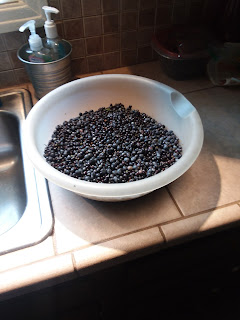Notes on Foraging in the Uinta Mountains
On various hikes I sought to make myself useful to my kind hosts and gathered first Oregon grapes, then elderberries and all along rose hips, the last, I believe the best source of vitamin C available.
I have harvested these between mid-July and mid-September.
This has been a drought year, with poor supplies of alpine berries, elderberries and Oregon grape, unless on irrigated ground.
I have found wild rose bushes from 6,500 to 9,500 feet, with their presence sharply declining after 9,000 feet.
They tend to keep company with young aspen, that white-barked tree which grows in groves like a mushroom, spreading clones underground. Aspen do well in burns. Thus roses are often found growing in ash-blackened soil.
Where the aspen return to pioneer tree life, roses will tend to cluster around rocks and boulders, at the base of rock slides and in dry washes and along stream traces trickling down to the creeks. In dryer areas they will be mostly on the down slope side of a road, where rare water has sunk into the soil.
At high elevation the bushes are small, about knee- to waist-high and each will have between six and twelve hips.
Where the forest has returned to scrub levels, with aspen as thick as your leg, below 8,500 feet the bushed may be chest-high in spots.
In irrigated places below 7,000 feet the rose bushes grow in towering thickets, 10-12 feet high, with juicier, but smaller hips.
In my favorite canyon, I have noticed that whenever the creek below is close enough to be heard, that the wild roses are most abundant, leaving me to wonder if they benefit from airborne moisture, because the creek is sometimes 100 feet below, and the bushes merely thigh high.
I have gathered about a bushel wet weight over the two month period. My hosts and I made jelly and syrup with elderberry and Oregon grape out of 5 quarts of the juiciest hips. The hips seem to be best for rendering when picked in wet areas and after the first frost. About 10 pounds dry weight remain in my host’s library, hung in a net sack. They were originally dried by laying in a baking pan in the sun and wind for a week.
Gathering requires a lot of bending over at the waist, so I limited picking to one hour in three of hiking time. Overall, the best thing about this activity are the scenic views had from cliff face tops and the bases of massive rock slides. I have gotten to the point where, when looking at a mountain, I can’t forget the sounds of the aspen rustling and the creeks falling that usually attend the habitat of the wild rose, drooping like a vernal bud on its thorny stalk.
(c) 2018 James LaFond



No comments:
Post a Comment